Strategic Human Resource Management: Diversity, Risk & Global HR
VerifiedAdded on 2023/04/23
|9
|1720
|52
Report
AI Summary
This report provides a comprehensive analysis of strategic human resource management, focusing on key elements such as diversity and inclusion, risk management, corporate social responsibility, and human resources in a global context. It explores strategies for managing generational differences in the workplace, implementing proactive HR policies to mitigate risks like workplace harassment and violence, fostering a culture of social responsibility within the organization and community, and preparing employees for expatriate assignments. The report emphasizes the importance of communication, adaptability, and technological advancements in managing a diverse workforce, as well as the role of HR in promoting ethical responsibilities and corporate social policies. Furthermore, it discusses the preparation of expatriates for global assignments, including cultural training and ongoing support, to ensure successful representation of the company in international markets. The document is available on Desklib, a platform offering a wide range of study tools and solved assignments for students.
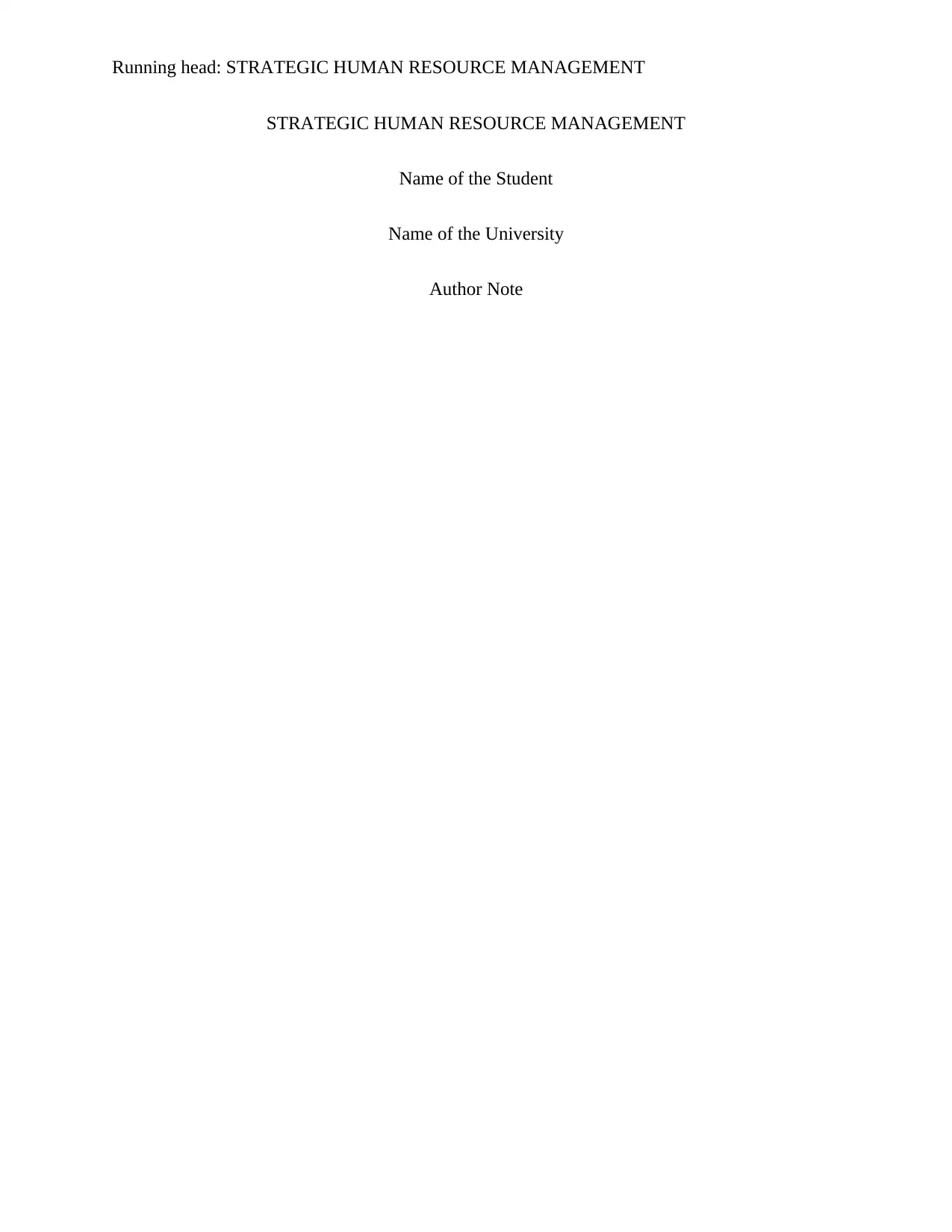
Running head: STRATEGIC HUMAN RESOURCE MANAGEMENT
STRATEGIC HUMAN RESOURCE MANAGEMENT
Name of the Student
Name of the University
Author Note
STRATEGIC HUMAN RESOURCE MANAGEMENT
Name of the Student
Name of the University
Author Note
Paraphrase This Document
Need a fresh take? Get an instant paraphrase of this document with our AI Paraphraser
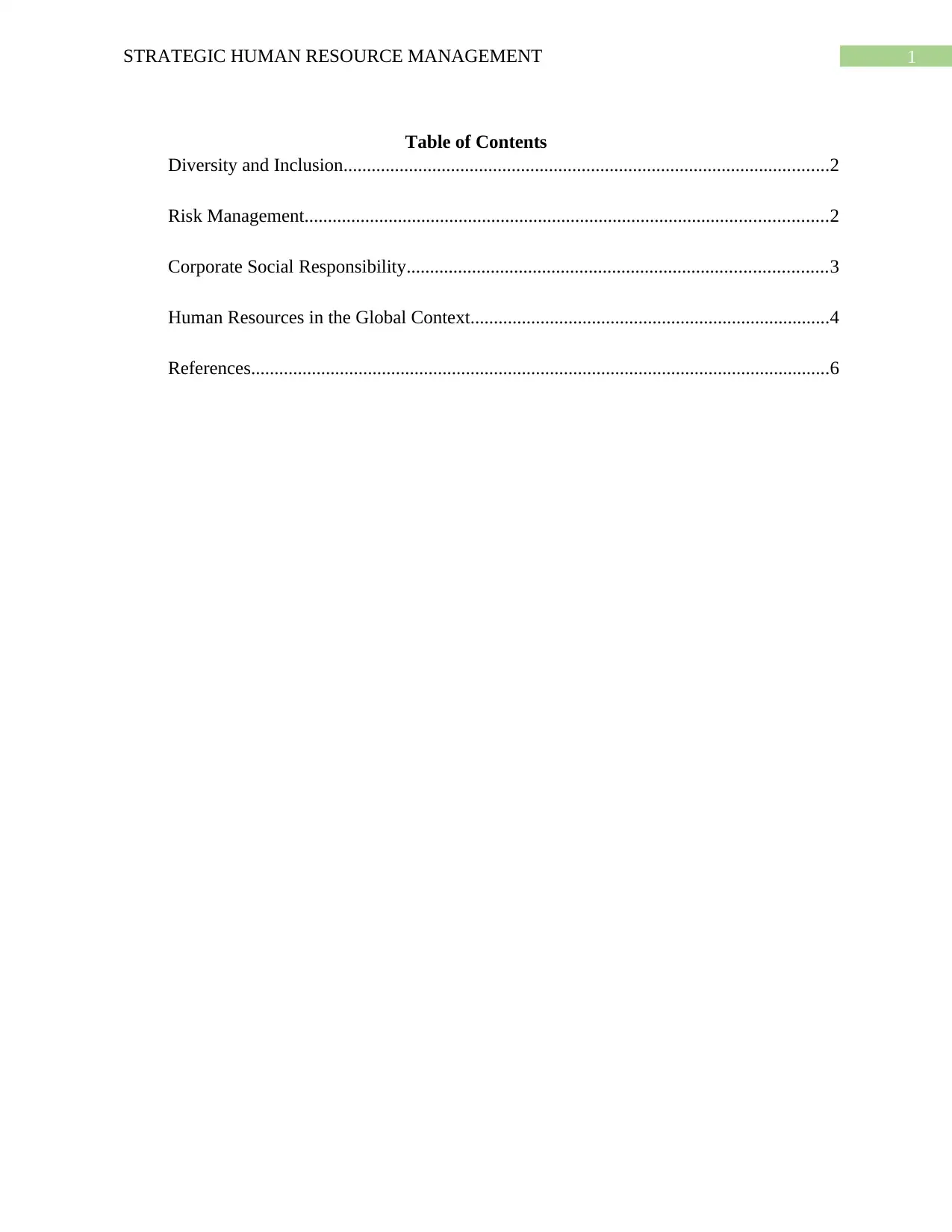
1STRATEGIC HUMAN RESOURCE MANAGEMENT
Table of Contents
Diversity and Inclusion........................................................................................................2
Risk Management................................................................................................................2
Corporate Social Responsibility..........................................................................................3
Human Resources in the Global Context.............................................................................4
References............................................................................................................................6
Table of Contents
Diversity and Inclusion........................................................................................................2
Risk Management................................................................................................................2
Corporate Social Responsibility..........................................................................................3
Human Resources in the Global Context.............................................................................4
References............................................................................................................................6
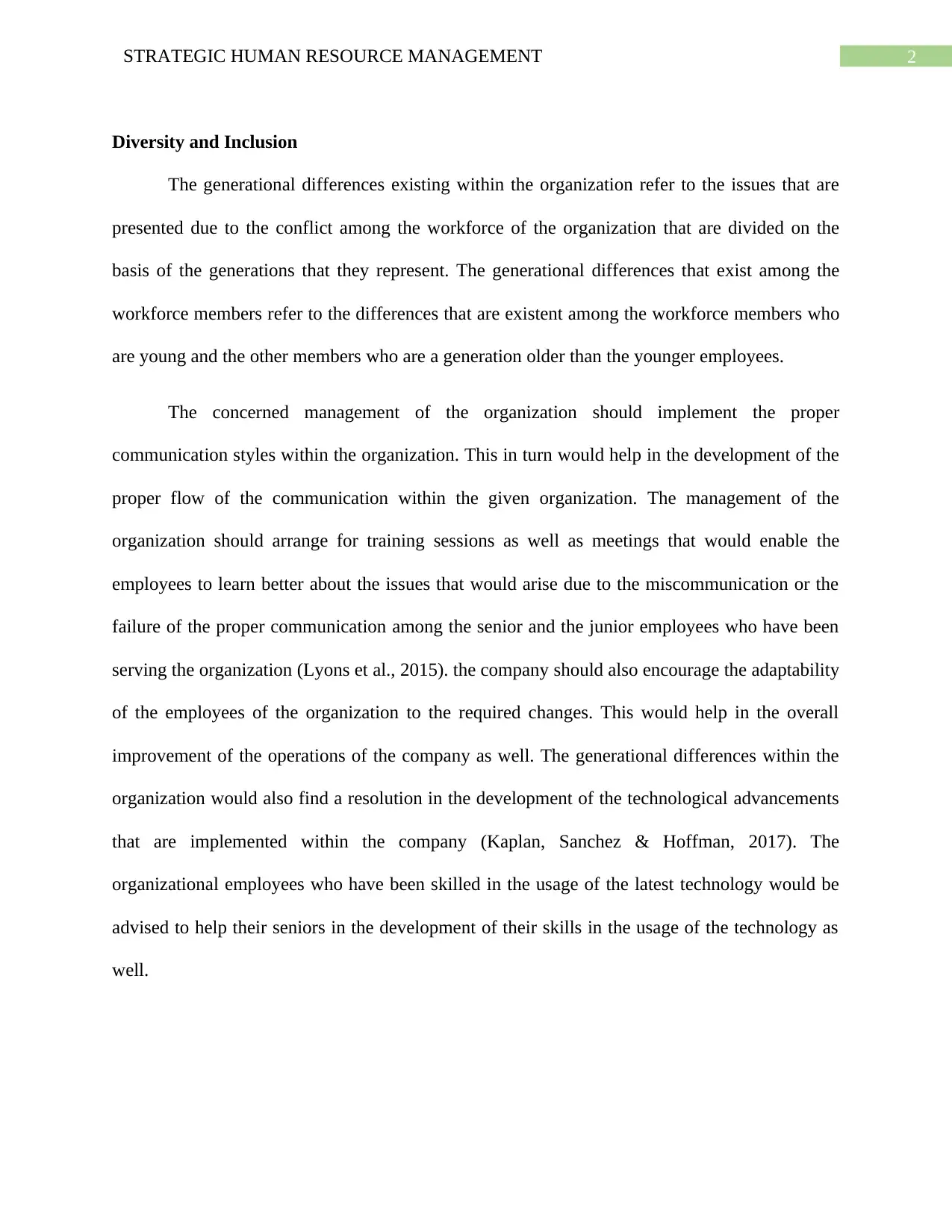
2STRATEGIC HUMAN RESOURCE MANAGEMENT
Diversity and Inclusion
The generational differences existing within the organization refer to the issues that are
presented due to the conflict among the workforce of the organization that are divided on the
basis of the generations that they represent. The generational differences that exist among the
workforce members refer to the differences that are existent among the workforce members who
are young and the other members who are a generation older than the younger employees.
The concerned management of the organization should implement the proper
communication styles within the organization. This in turn would help in the development of the
proper flow of the communication within the given organization. The management of the
organization should arrange for training sessions as well as meetings that would enable the
employees to learn better about the issues that would arise due to the miscommunication or the
failure of the proper communication among the senior and the junior employees who have been
serving the organization (Lyons et al., 2015). the company should also encourage the adaptability
of the employees of the organization to the required changes. This would help in the overall
improvement of the operations of the company as well. The generational differences within the
organization would also find a resolution in the development of the technological advancements
that are implemented within the company (Kaplan, Sanchez & Hoffman, 2017). The
organizational employees who have been skilled in the usage of the latest technology would be
advised to help their seniors in the development of their skills in the usage of the technology as
well.
Diversity and Inclusion
The generational differences existing within the organization refer to the issues that are
presented due to the conflict among the workforce of the organization that are divided on the
basis of the generations that they represent. The generational differences that exist among the
workforce members refer to the differences that are existent among the workforce members who
are young and the other members who are a generation older than the younger employees.
The concerned management of the organization should implement the proper
communication styles within the organization. This in turn would help in the development of the
proper flow of the communication within the given organization. The management of the
organization should arrange for training sessions as well as meetings that would enable the
employees to learn better about the issues that would arise due to the miscommunication or the
failure of the proper communication among the senior and the junior employees who have been
serving the organization (Lyons et al., 2015). the company should also encourage the adaptability
of the employees of the organization to the required changes. This would help in the overall
improvement of the operations of the company as well. The generational differences within the
organization would also find a resolution in the development of the technological advancements
that are implemented within the company (Kaplan, Sanchez & Hoffman, 2017). The
organizational employees who have been skilled in the usage of the latest technology would be
advised to help their seniors in the development of their skills in the usage of the technology as
well.
⊘ This is a preview!⊘
Do you want full access?
Subscribe today to unlock all pages.

Trusted by 1+ million students worldwide

3STRATEGIC HUMAN RESOURCE MANAGEMENT
Risk Management
The risk management within the organization is another factor that is of huge importance
in case of the business organizations that have been operating within the present-day business
environment. The proactive risk management as is undertaken by the various members of the
human resources department of the organization is known to be one of the major activities of the
human resources department for the management of the risks faced by the company (Fox et al.,
2018). The proactive nature of the human resource department of the company refers to the
condition wherein the concerned department of the company is responsible for the identification
and the mitigation of the risks that might pose to be a threat to the improvement of the operations
of the company. The companies that have been featuring within the given organization might be
advised to implement the various strategies that might help in the prevention of several risks like
those that are faced by the company in terms of the workplace harassment and workplace
violence as well as the several policies for the non-discrimination.
The risk management on the part of the human resource department of the organization
tends to help the organization maintain the productivity level of the organization. This in turn
helps in the management of the retention in case of the employees. The risk that is faced by the
business organizations are generally resolved by the human resource department by hiring the
employees who are best suited for the job. The risks that are faced by the company majorly affect
the overall performance of the company. The proactivity on the part of the human resource
department of the organization tend to involve the majority of the workforce in the improvement
of the activities that are undertaken by the given organization (Alphonse et al., 2018). This in
turn would help in increasing the competitive advantage of the concerned organization in the
given market.
Risk Management
The risk management within the organization is another factor that is of huge importance
in case of the business organizations that have been operating within the present-day business
environment. The proactive risk management as is undertaken by the various members of the
human resources department of the organization is known to be one of the major activities of the
human resources department for the management of the risks faced by the company (Fox et al.,
2018). The proactive nature of the human resource department of the company refers to the
condition wherein the concerned department of the company is responsible for the identification
and the mitigation of the risks that might pose to be a threat to the improvement of the operations
of the company. The companies that have been featuring within the given organization might be
advised to implement the various strategies that might help in the prevention of several risks like
those that are faced by the company in terms of the workplace harassment and workplace
violence as well as the several policies for the non-discrimination.
The risk management on the part of the human resource department of the organization
tends to help the organization maintain the productivity level of the organization. This in turn
helps in the management of the retention in case of the employees. The risk that is faced by the
business organizations are generally resolved by the human resource department by hiring the
employees who are best suited for the job. The risks that are faced by the company majorly affect
the overall performance of the company. The proactivity on the part of the human resource
department of the organization tend to involve the majority of the workforce in the improvement
of the activities that are undertaken by the given organization (Alphonse et al., 2018). This in
turn would help in increasing the competitive advantage of the concerned organization in the
given market.
Paraphrase This Document
Need a fresh take? Get an instant paraphrase of this document with our AI Paraphraser
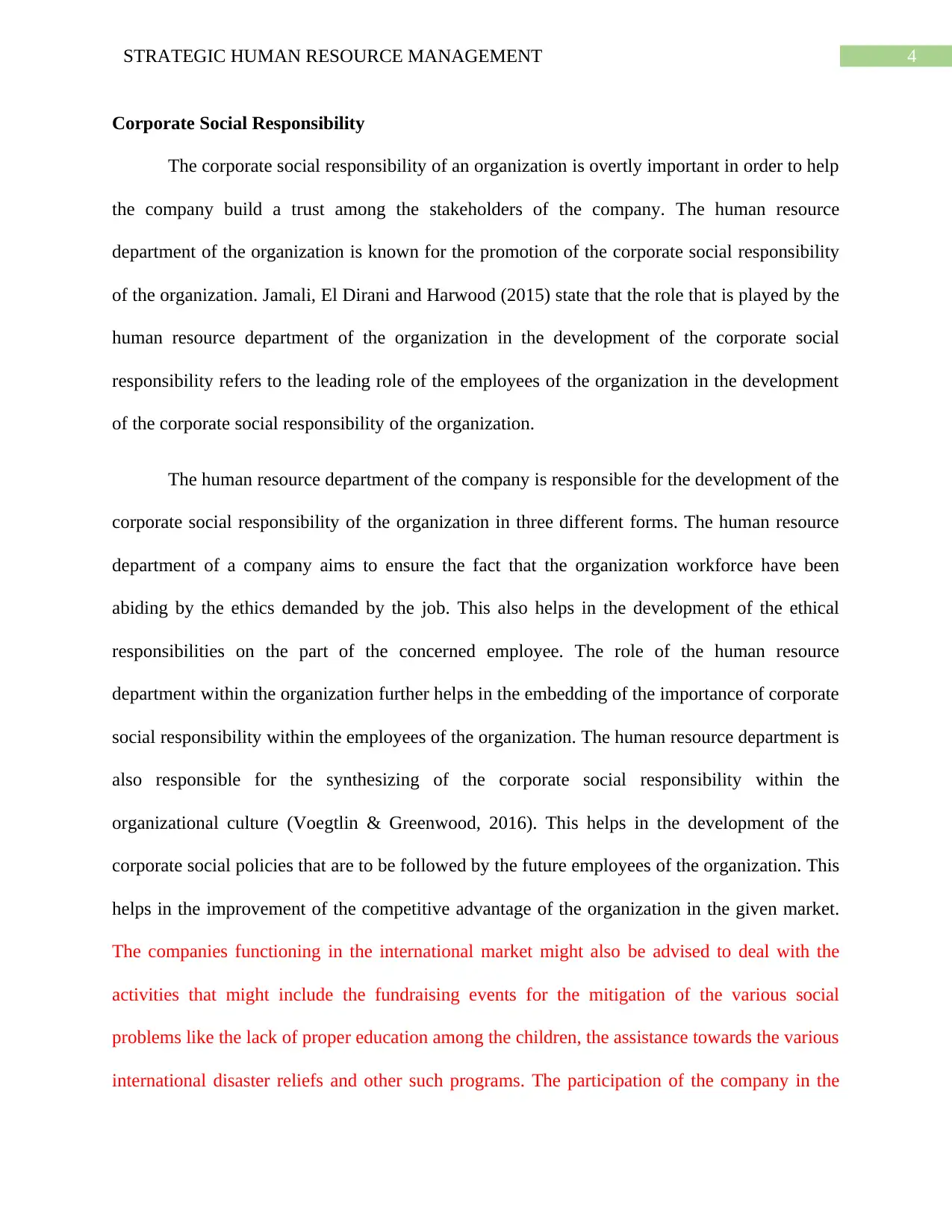
4STRATEGIC HUMAN RESOURCE MANAGEMENT
Corporate Social Responsibility
The corporate social responsibility of an organization is overtly important in order to help
the company build a trust among the stakeholders of the company. The human resource
department of the organization is known for the promotion of the corporate social responsibility
of the organization. Jamali, El Dirani and Harwood (2015) state that the role that is played by the
human resource department of the organization in the development of the corporate social
responsibility refers to the leading role of the employees of the organization in the development
of the corporate social responsibility of the organization.
The human resource department of the company is responsible for the development of the
corporate social responsibility of the organization in three different forms. The human resource
department of a company aims to ensure the fact that the organization workforce have been
abiding by the ethics demanded by the job. This also helps in the development of the ethical
responsibilities on the part of the concerned employee. The role of the human resource
department within the organization further helps in the embedding of the importance of corporate
social responsibility within the employees of the organization. The human resource department is
also responsible for the synthesizing of the corporate social responsibility within the
organizational culture (Voegtlin & Greenwood, 2016). This helps in the development of the
corporate social policies that are to be followed by the future employees of the organization. This
helps in the improvement of the competitive advantage of the organization in the given market.
The companies functioning in the international market might also be advised to deal with the
activities that might include the fundraising events for the mitigation of the various social
problems like the lack of proper education among the children, the assistance towards the various
international disaster reliefs and other such programs. The participation of the company in the
Corporate Social Responsibility
The corporate social responsibility of an organization is overtly important in order to help
the company build a trust among the stakeholders of the company. The human resource
department of the organization is known for the promotion of the corporate social responsibility
of the organization. Jamali, El Dirani and Harwood (2015) state that the role that is played by the
human resource department of the organization in the development of the corporate social
responsibility refers to the leading role of the employees of the organization in the development
of the corporate social responsibility of the organization.
The human resource department of the company is responsible for the development of the
corporate social responsibility of the organization in three different forms. The human resource
department of a company aims to ensure the fact that the organization workforce have been
abiding by the ethics demanded by the job. This also helps in the development of the ethical
responsibilities on the part of the concerned employee. The role of the human resource
department within the organization further helps in the embedding of the importance of corporate
social responsibility within the employees of the organization. The human resource department is
also responsible for the synthesizing of the corporate social responsibility within the
organizational culture (Voegtlin & Greenwood, 2016). This helps in the development of the
corporate social policies that are to be followed by the future employees of the organization. This
helps in the improvement of the competitive advantage of the organization in the given market.
The companies functioning in the international market might also be advised to deal with the
activities that might include the fundraising events for the mitigation of the various social
problems like the lack of proper education among the children, the assistance towards the various
international disaster reliefs and other such programs. The participation of the company in the
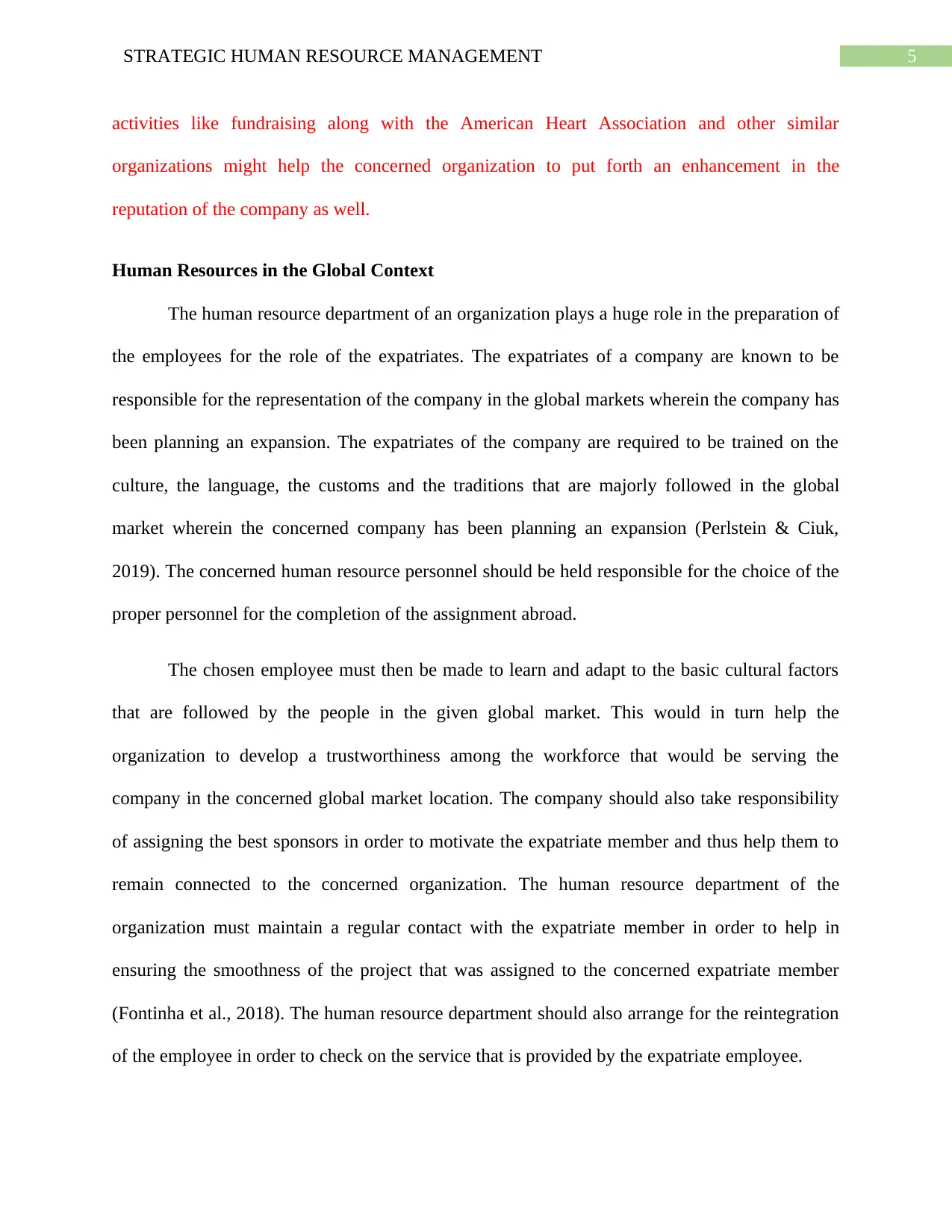
5STRATEGIC HUMAN RESOURCE MANAGEMENT
activities like fundraising along with the American Heart Association and other similar
organizations might help the concerned organization to put forth an enhancement in the
reputation of the company as well.
Human Resources in the Global Context
The human resource department of an organization plays a huge role in the preparation of
the employees for the role of the expatriates. The expatriates of a company are known to be
responsible for the representation of the company in the global markets wherein the company has
been planning an expansion. The expatriates of the company are required to be trained on the
culture, the language, the customs and the traditions that are majorly followed in the global
market wherein the concerned company has been planning an expansion (Perlstein & Ciuk,
2019). The concerned human resource personnel should be held responsible for the choice of the
proper personnel for the completion of the assignment abroad.
The chosen employee must then be made to learn and adapt to the basic cultural factors
that are followed by the people in the given global market. This would in turn help the
organization to develop a trustworthiness among the workforce that would be serving the
company in the concerned global market location. The company should also take responsibility
of assigning the best sponsors in order to motivate the expatriate member and thus help them to
remain connected to the concerned organization. The human resource department of the
organization must maintain a regular contact with the expatriate member in order to help in
ensuring the smoothness of the project that was assigned to the concerned expatriate member
(Fontinha et al., 2018). The human resource department should also arrange for the reintegration
of the employee in order to check on the service that is provided by the expatriate employee.
activities like fundraising along with the American Heart Association and other similar
organizations might help the concerned organization to put forth an enhancement in the
reputation of the company as well.
Human Resources in the Global Context
The human resource department of an organization plays a huge role in the preparation of
the employees for the role of the expatriates. The expatriates of a company are known to be
responsible for the representation of the company in the global markets wherein the company has
been planning an expansion. The expatriates of the company are required to be trained on the
culture, the language, the customs and the traditions that are majorly followed in the global
market wherein the concerned company has been planning an expansion (Perlstein & Ciuk,
2019). The concerned human resource personnel should be held responsible for the choice of the
proper personnel for the completion of the assignment abroad.
The chosen employee must then be made to learn and adapt to the basic cultural factors
that are followed by the people in the given global market. This would in turn help the
organization to develop a trustworthiness among the workforce that would be serving the
company in the concerned global market location. The company should also take responsibility
of assigning the best sponsors in order to motivate the expatriate member and thus help them to
remain connected to the concerned organization. The human resource department of the
organization must maintain a regular contact with the expatriate member in order to help in
ensuring the smoothness of the project that was assigned to the concerned expatriate member
(Fontinha et al., 2018). The human resource department should also arrange for the reintegration
of the employee in order to check on the service that is provided by the expatriate employee.
⊘ This is a preview!⊘
Do you want full access?
Subscribe today to unlock all pages.

Trusted by 1+ million students worldwide
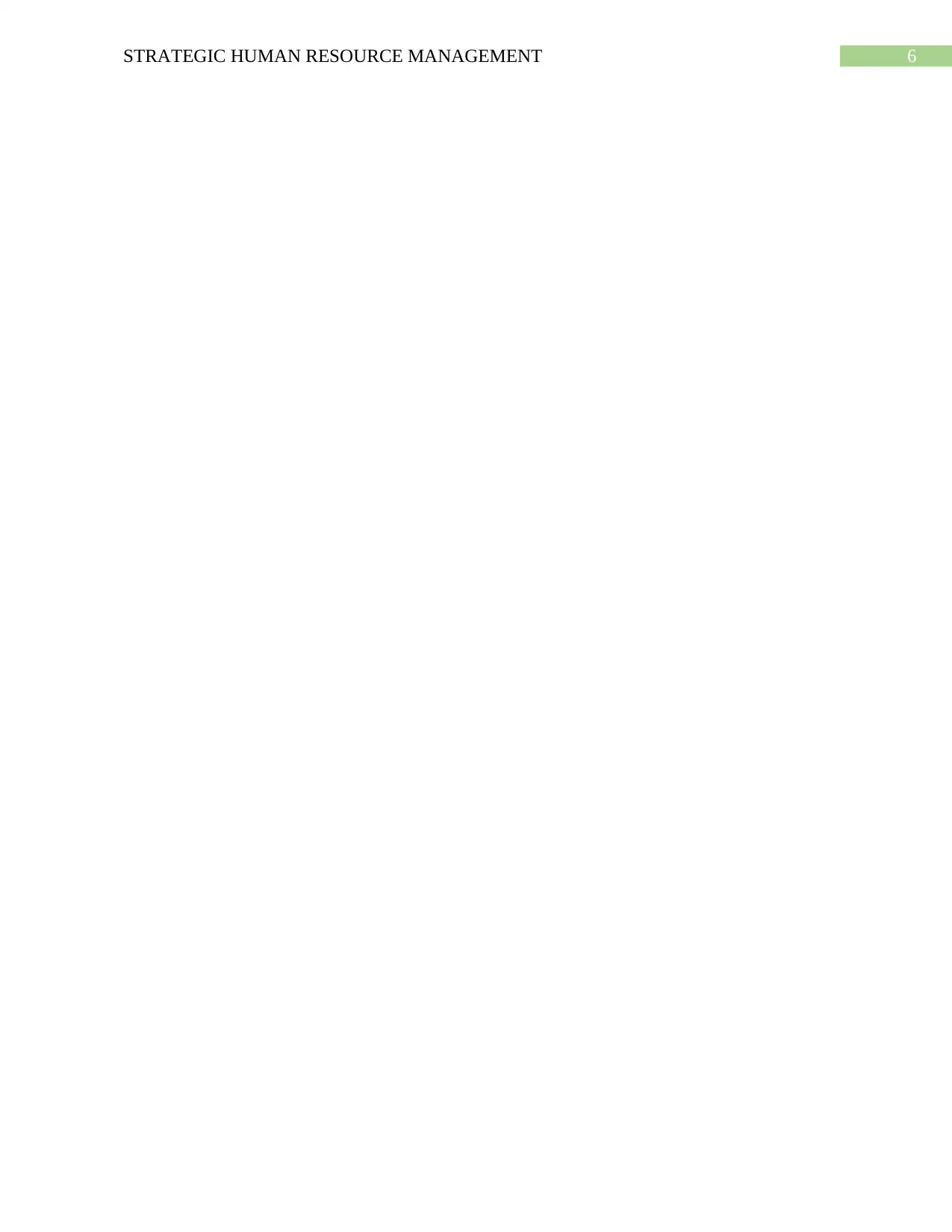
6STRATEGIC HUMAN RESOURCE MANAGEMENT
Paraphrase This Document
Need a fresh take? Get an instant paraphrase of this document with our AI Paraphraser
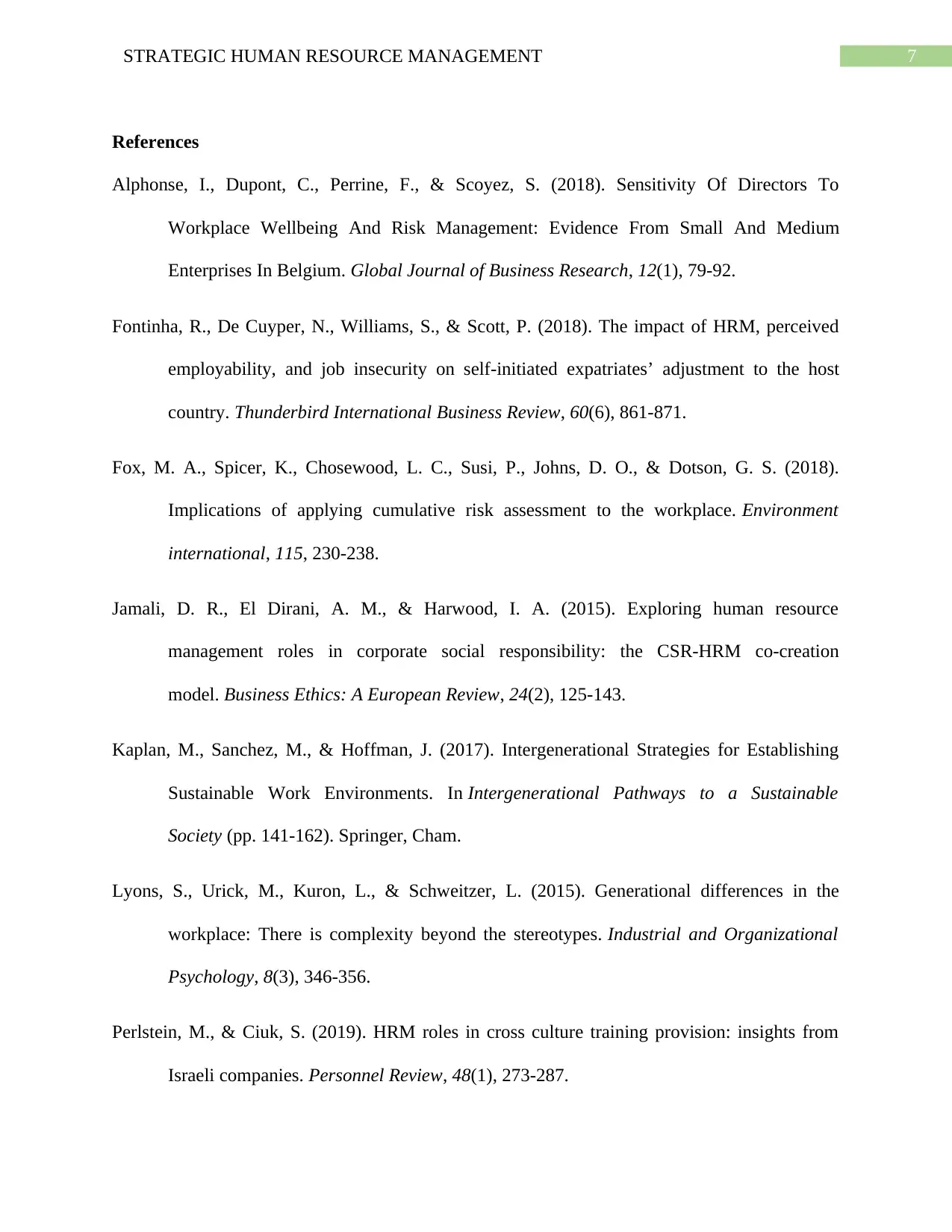
7STRATEGIC HUMAN RESOURCE MANAGEMENT
References
Alphonse, I., Dupont, C., Perrine, F., & Scoyez, S. (2018). Sensitivity Of Directors To
Workplace Wellbeing And Risk Management: Evidence From Small And Medium
Enterprises In Belgium. Global Journal of Business Research, 12(1), 79-92.
Fontinha, R., De Cuyper, N., Williams, S., & Scott, P. (2018). The impact of HRM, perceived
employability, and job insecurity on self‐initiated expatriates’ adjustment to the host
country. Thunderbird International Business Review, 60(6), 861-871.
Fox, M. A., Spicer, K., Chosewood, L. C., Susi, P., Johns, D. O., & Dotson, G. S. (2018).
Implications of applying cumulative risk assessment to the workplace. Environment
international, 115, 230-238.
Jamali, D. R., El Dirani, A. M., & Harwood, I. A. (2015). Exploring human resource
management roles in corporate social responsibility: the CSR‐HRM co‐creation
model. Business Ethics: A European Review, 24(2), 125-143.
Kaplan, M., Sanchez, M., & Hoffman, J. (2017). Intergenerational Strategies for Establishing
Sustainable Work Environments. In Intergenerational Pathways to a Sustainable
Society (pp. 141-162). Springer, Cham.
Lyons, S., Urick, M., Kuron, L., & Schweitzer, L. (2015). Generational differences in the
workplace: There is complexity beyond the stereotypes. Industrial and Organizational
Psychology, 8(3), 346-356.
Perlstein, M., & Ciuk, S. (2019). HRM roles in cross culture training provision: insights from
Israeli companies. Personnel Review, 48(1), 273-287.
References
Alphonse, I., Dupont, C., Perrine, F., & Scoyez, S. (2018). Sensitivity Of Directors To
Workplace Wellbeing And Risk Management: Evidence From Small And Medium
Enterprises In Belgium. Global Journal of Business Research, 12(1), 79-92.
Fontinha, R., De Cuyper, N., Williams, S., & Scott, P. (2018). The impact of HRM, perceived
employability, and job insecurity on self‐initiated expatriates’ adjustment to the host
country. Thunderbird International Business Review, 60(6), 861-871.
Fox, M. A., Spicer, K., Chosewood, L. C., Susi, P., Johns, D. O., & Dotson, G. S. (2018).
Implications of applying cumulative risk assessment to the workplace. Environment
international, 115, 230-238.
Jamali, D. R., El Dirani, A. M., & Harwood, I. A. (2015). Exploring human resource
management roles in corporate social responsibility: the CSR‐HRM co‐creation
model. Business Ethics: A European Review, 24(2), 125-143.
Kaplan, M., Sanchez, M., & Hoffman, J. (2017). Intergenerational Strategies for Establishing
Sustainable Work Environments. In Intergenerational Pathways to a Sustainable
Society (pp. 141-162). Springer, Cham.
Lyons, S., Urick, M., Kuron, L., & Schweitzer, L. (2015). Generational differences in the
workplace: There is complexity beyond the stereotypes. Industrial and Organizational
Psychology, 8(3), 346-356.
Perlstein, M., & Ciuk, S. (2019). HRM roles in cross culture training provision: insights from
Israeli companies. Personnel Review, 48(1), 273-287.
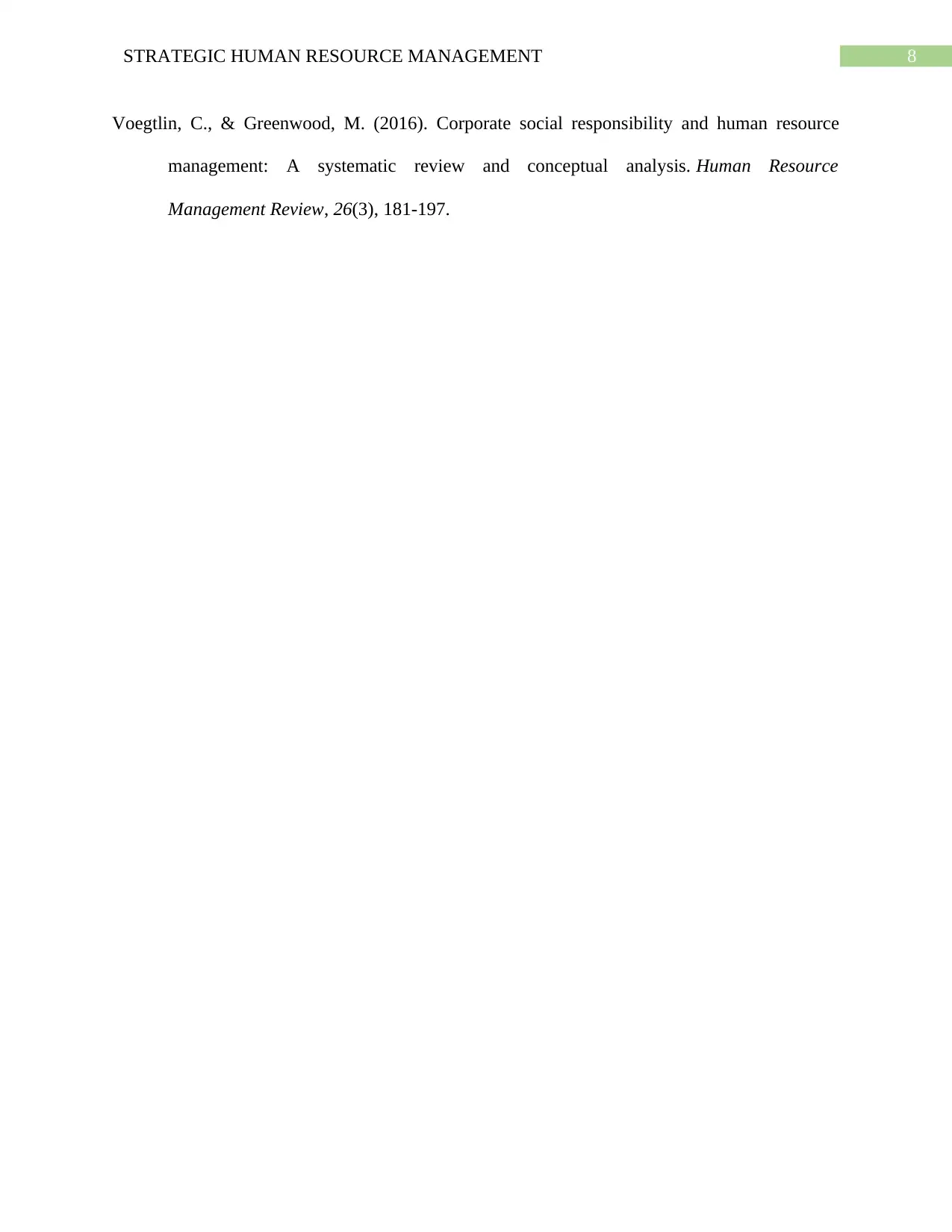
8STRATEGIC HUMAN RESOURCE MANAGEMENT
Voegtlin, C., & Greenwood, M. (2016). Corporate social responsibility and human resource
management: A systematic review and conceptual analysis. Human Resource
Management Review, 26(3), 181-197.
Voegtlin, C., & Greenwood, M. (2016). Corporate social responsibility and human resource
management: A systematic review and conceptual analysis. Human Resource
Management Review, 26(3), 181-197.
⊘ This is a preview!⊘
Do you want full access?
Subscribe today to unlock all pages.

Trusted by 1+ million students worldwide
1 out of 9
Related Documents
Your All-in-One AI-Powered Toolkit for Academic Success.
+13062052269
info@desklib.com
Available 24*7 on WhatsApp / Email
![[object Object]](/_next/static/media/star-bottom.7253800d.svg)
Unlock your academic potential
Copyright © 2020–2025 A2Z Services. All Rights Reserved. Developed and managed by ZUCOL.





